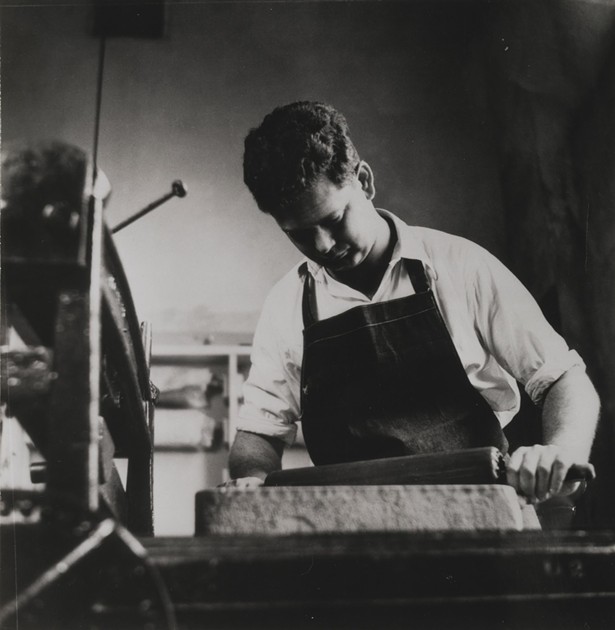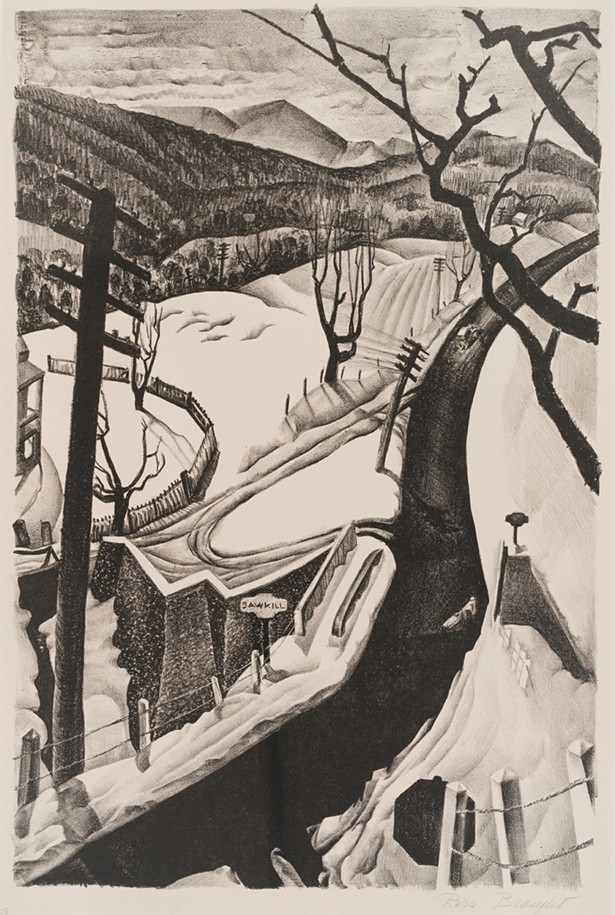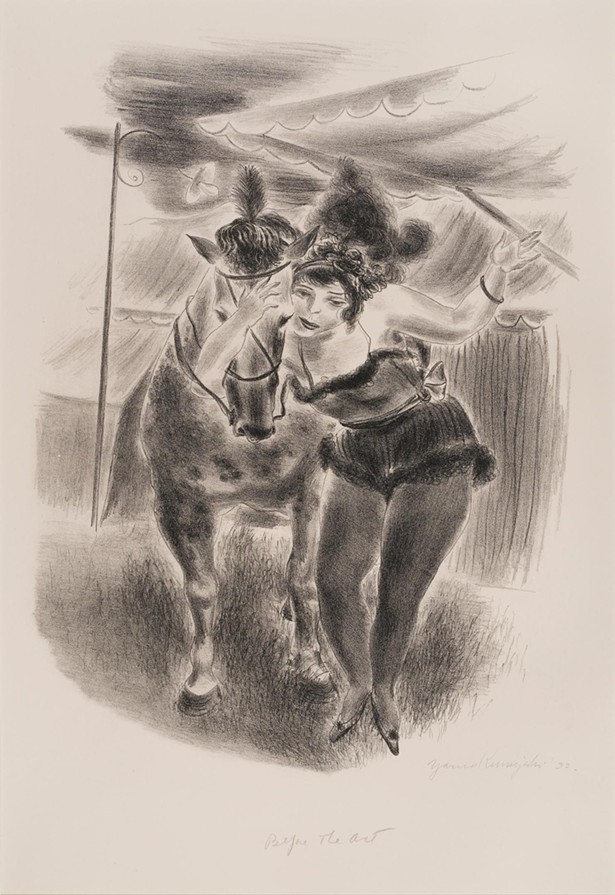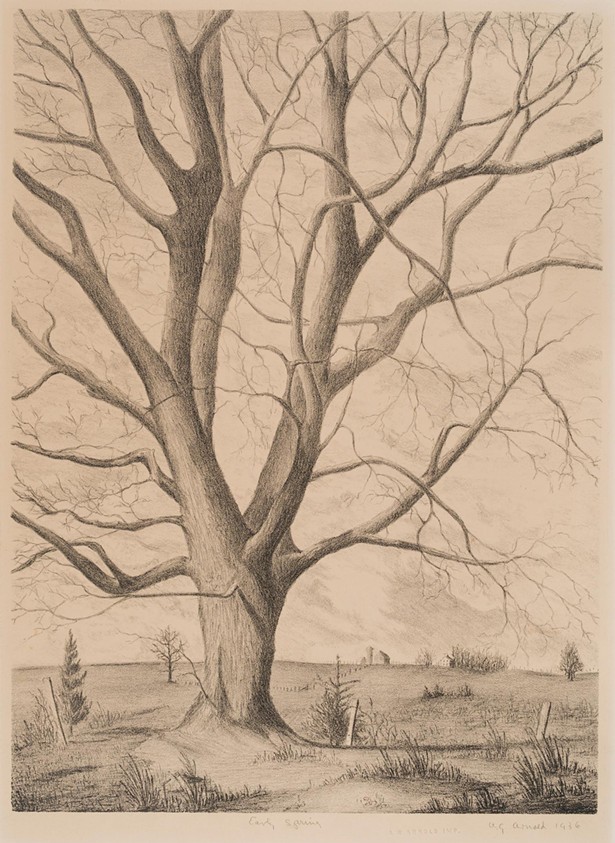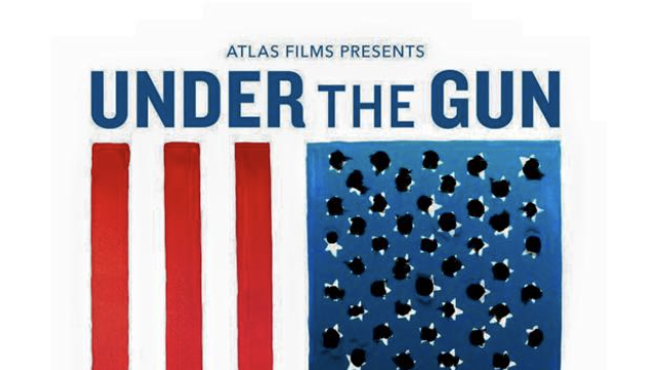Grant Arnold in Woodstock in the 1930s. In 1930, Hervey White, founder of the Maverick art colony in West Hurley, was searching for a lithographer. He heard about an earnest young printmaker at the Art Students League named Grant Arnold and offered him a sweet deal: a lithography studio, a cottage to sleep in, and all the food he could eat—for five dollars a week. Arnold remained in Woodstock, with occasional breaks, until 1945, producing hundreds of prints, 69 of which are now on display at the Woodstock School of Art.
Spanning from 1930 to 1940 and including 10 of Arnold's own works, this is essentially a survey of 20th-century Woodstock artists. This was before American art got weird, invaded by European Surrealists fleeing fascism. There's only one abstract image, Emmett Edwards' s Abstraction, which pretty clearly resembles trees being tossed by the wind.
Lithography, literally "stone writing," is a laborious printing method that involves drawing a picture on a limestone slab and treating it repeatedly with chemicals. (A video at the exhibition details the process.) The more Arnold printed, the better he got. "You can see the progression of his talent," observes curator Bruce Weber.
These are all printer's proofs, in immaculate condition, taken from a collection at SUNY Oswego, where Arnold worked as an adjunct professor in his later years.
Of the three traditional subjects of art—landscape, still life, and the human figure—the first predominates. It's not easy to convey autumn in black and white, so most of the landscapes depict summer or winter.
There are few bowls of fruit, but a number of quizzical portraits. Some of the subjects look like character actors from screwball comedies of the 1930s, such as Native of Woodstock (Hurley) by Adolph Dehn: a slim elderly gent in a kooky golf cap, worn jacket, knickerbockers, and knee socks.
My favorite of Arnold's own artworks, Piano Piece, shows a woman with a hopeful but mildly bewildered expression, sitting at an upright piano, attempting to play a difficult musical score. In the window behind her—framed by flowered curtains—stretches a bucolic meadow. (The title, of course, is a pun; because the artwork itself is a "piece.")
In response to the Great Depression, there are gestures of social commitment, of what was then called—and is now again called—the "progressive movement." Industrial Landscape by Paul R. Meltsner shows four muscular laborers surrounded by machinery, in a quasi-Cubist tableau reminiscent of Fernand Leger's art: the worker as hero. Prentiss Taylor's Christ in Alabama, based on a Langston Hughes poem, presents an African-American man with arms outstretched, in silhouette, posed against a white, stylized cross—the merciless cross of American racism?
There are a couple of revealing feminine self-portraits. One by Barbara Shermund, a longtime illustrator for the New Yorker, depicts a shrewd, cautious, big-eyed woman with a helmet of hair, surrounded by darkness.
"This was the Maverick cat; everyone fed the Maverick cat," Weber remarks, pointing to a Lucille Blanch print. The cat, Maggie, snuck inside Blanch's closet to give birth, so the artist immortalized the event with a drawing. We see three baby cats from behind feeding at Maggie's teats, as the long-suffering mother gazes off. Lithography perfectly conveys the softness of kitten fur.
The most well-known artist is Thomas Hart Benton, who taught at the Art Students League. Coming Round the Mountain shows five loose-limbed Ozark musicians playing a song (on fiddle, guitar, accordion, plus two singers) while in the upper right-hand corner, the subject of their song, a woman in a jouncing wagon, is literally coming around the mountain, driving six half-crazed horses.







